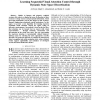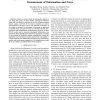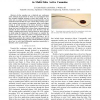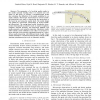ICRA
2009
IEEE
14 years 6 months ago
2009
IEEE
² Similar to humans and primates, artificial creatures like robots are limited in terms of allocation of their resources to huge sensory and perceptual information. Serial process...
ICRA
2009
IEEE
14 years 6 months ago
2009
IEEE
Abstract— The most widely applied resource allocation strategy is to balance, or equalize, the total workload assigned to each resource. In mobile multi-agent systems, this princ...
ICRA
2009
IEEE
14 years 6 months ago
2009
IEEE
—Unstructured, human environments present great challenges and opportunities for robotic manipulation and grasping. Robots that reliably grasp household objects with unknown or u...
ICRA
2009
IEEE
14 years 6 months ago
2009
IEEE
ICRA
2009
IEEE
14 years 6 months ago
2009
IEEE
— Visual localization and mapping for mobile robots has been achieved with a large variety of methods. Among them, topological navigation using vision has the advantage of offeri...
ICRA
2009
IEEE
14 years 6 months ago
2009
IEEE
— The ballbot is a dynamically stable mobile robot that moves on a single spherical wheel and is capable of omnidirectional movement. The ballbot is an underactuated system with ...
ICRA
2009
IEEE
14 years 6 months ago
2009
IEEE
Abstract—We present a motion planning algorithm that computes rough trajectories used by a contact-points planner as a guide to grow its search graph. We adapt collision-free mot...
ICRA
2009
IEEE
14 years 6 months ago
2009
IEEE
— Active cannulas are a relatively new continuum robot subclass characterized by their use of preshaped tubes that transmit bending moments as they slide within one another and a...
ICRA
2009
IEEE
14 years 6 months ago
2009
IEEE
— The asymmetry of a bevel-tip needle results in the needle naturally bending when it is inserted into soft tissue. In this study we present a mechanics-based model that calculat...
ICRA
2009
IEEE
14 years 6 months ago
2009
IEEE
— A new lossy compression method is proposed for haptic (force, velocity) data as exchanged in bilateral telepresence systems. The method is based on the passive extrapolative co...




